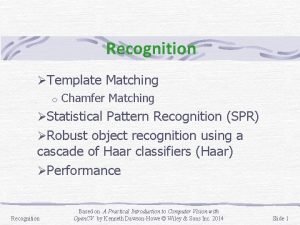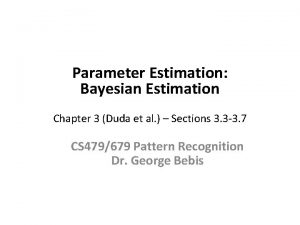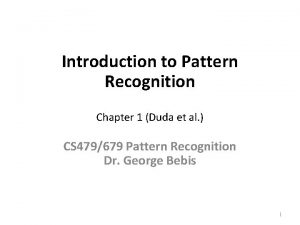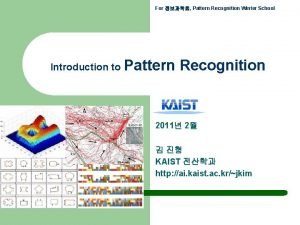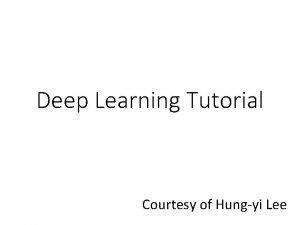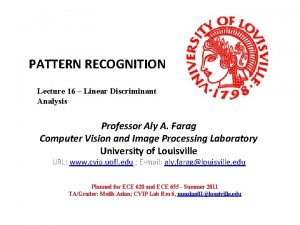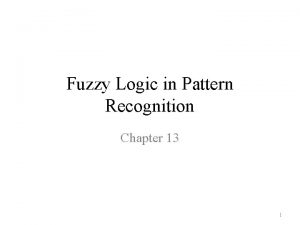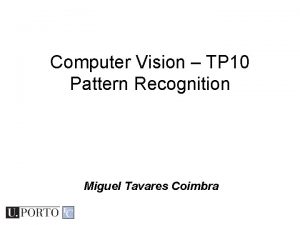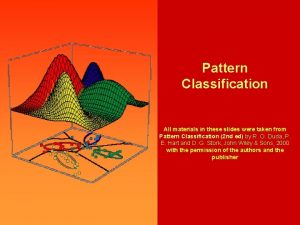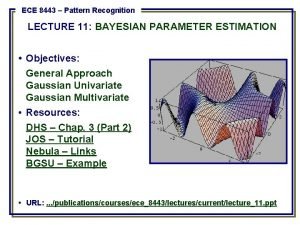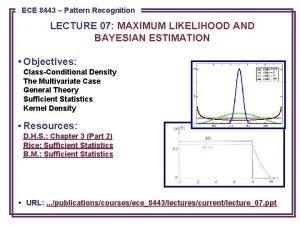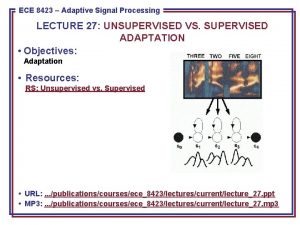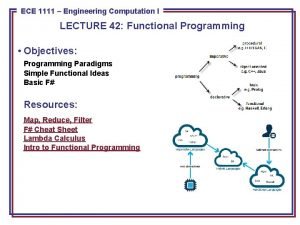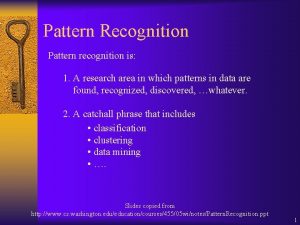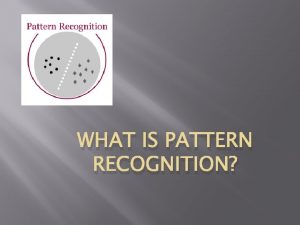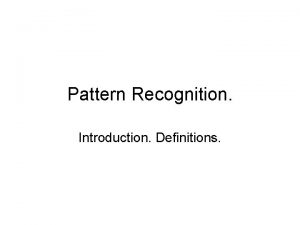240 650 Principles of Pattern Recognition Montri Karnjanadecha





















- Slides: 21

240 -650 Principles of Pattern Recognition Montri Karnjanadecha montri@coe. psu. ac. th http: //fivedots. coe. psu. ac. th/~montri 240 -650: Chapter 3: Maximum-Likelihood and Baysian Parameter Estimation 1

Chapter 3 Maximum-Likelihood and Bayesian Parameter Estimation 240 -650: Chapter 3: Maximum-Likelihood and Baysian Parameter Estimation 2

Introduction • We could design an optimum classifier if we know P(wi) and p(x|wi) • We rarely have knowledge about the probabilistic structure of the problem • We often estimate P(wi) and p(x|wi) from training data or design samples 240 -650: Chapter 3: Maximum-Likelihood and Baysian Parameter Estimation 3

Maximum-Likelihood Estimation • ML Estimation • Always have good convergence properties as the number of training samples increases • Simpler that other methods 240 -650: Chapter 3: Maximum-Likelihood and Baysian Parameter Estimation 4

The General Principle • Suppose we separate a collection of samples according to class so that we have c data sets, D 1, …, Dc with the samples in Dj having been drawn independently according to the probability law p(x|wj) • We say such samples are i. i. d. – independently and identically distributed random variable 240 -650: Chapter 3: Maximum-Likelihood and Baysian Parameter Estimation 5

The General Principle • We assume that p(x|wj) has a known parametric form and is determined uniquely by the value of a parameter vector qj • For example • We explicitly write p(x|wj) as p(x|wj, qj) 240 -650: Chapter 3: Maximum-Likelihood and Baysian Parameter Estimation 6

Problem Statement • To use the information provided by the training samples to obtain good estimates for the unknown parameter vectors q 1, …qc associated with each category 240 -650: Chapter 3: Maximum-Likelihood and Baysian Parameter Estimation 7

Simplified Problem Statement • If samples in Di give no information about qj if i=j • We now have c separated problems of the following form: To use a set D of training samples drawn independently from the probability density p(x|q) to estimate the unknown vector q. 240 -650: Chapter 3: Maximum-Likelihood and Baysian Parameter Estimation 8

• Suppose that D contains n samples, x 1, …, xn. • Then we have Likelihood of q with respect to the set of samples • The Maximum-Likelihood estimate of q is the value of that maximizes p(D|q) 240 -650: Chapter 3: Maximum-Likelihood and Baysian Parameter Estimation 9

240 -650: Chapter 3: Maximum-Likelihood and Baysian Parameter Estimation 10

• Let q = (q 1, …, qp)t • Let be the gradient operator 240 -650: Chapter 3: Maximum-Likelihood and Baysian Parameter Estimation 11

Log-Likelihood Function • We define l(q) as the log-likelihood function • We can write our solution as 240 -650: Chapter 3: Maximum-Likelihood and Baysian Parameter Estimation 12

MLE • From • We have • And • Necessary condition for MLE 240 -650: Chapter 3: Maximum-Likelihood and Baysian Parameter Estimation 13

The Gaussian Case: Unknown m • Suppose that the samples are drawn from a multivariate normal population with mean m and covariance matrix S • Let m is the only unknown • Consider a sample point xk and find • and 240 -650: Chapter 3: Maximum-Likelihood and Baysian Parameter Estimation 14

• The MLE of m must satisfy • After rearranging 240 -650: Chapter 3: Maximum-Likelihood and Baysian Parameter Estimation 15

Sample Mean • The MLE for the unknown population meanis just the arithmetic average of the training samples (or sample mean) • If we think of the n samples as a cloud of points, then the sample mean is the centroid of the cloud 240 -650: Chapter 3: Maximum-Likelihood and Baysian Parameter Estimation 16

The Gaussian Case: Unknown m and S • This is a more typical case where mean and covariance matrix are unknown • Consider the univariate case with q 1=m and q 2=s 2 240 -650: Chapter 3: Maximum-Likelihood and Baysian Parameter Estimation 17

• And its derivative is • Set to 0 • and 240 -650: Chapter 3: Maximum-Likelihood and Baysian Parameter Estimation 18

• With a little rearranging, we have 240 -650: Chapter 3: Maximum-Likelihood and Baysian Parameter Estimation 19

MLE for multivariate case 240 -650: Chapter 3: Maximum-Likelihood and Baysian Parameter Estimation 20

Bias • The MLE for the variance s 2 is biased • The expected value over all data sets of size n of the sample variance is not equal to the true variance • An Unbiased estimator for S is given by 240 -650: Chapter 3: Maximum-Likelihood and Baysian Parameter Estimation 21
 Template matching pattern recognition
Template matching pattern recognition Bayesian parameter estimation in pattern recognition
Bayesian parameter estimation in pattern recognition Pattern recognition duda
Pattern recognition duda Fuzzy classification in pattern recognition
Fuzzy classification in pattern recognition Design cycle of pattern recognition
Design cycle of pattern recognition Pattern recognition
Pattern recognition Pattern recognition lab
Pattern recognition lab Pattern recognition clinical reasoning
Pattern recognition clinical reasoning Contoh pattern recognition
Contoh pattern recognition Discriminant function in pattern recognition
Discriminant function in pattern recognition Fuzzy logic in pattern recognition
Fuzzy logic in pattern recognition Pattern recognition
Pattern recognition Flickr
Flickr Inlay wax pattern fabrication
Inlay wax pattern fabrication Pengertian pola digital
Pengertian pola digital Pattern recognition slides
Pattern recognition slides Picture recognition
Picture recognition Isip ece 1111
Isip ece 1111 Bayesian parameter estimation in pattern recognition
Bayesian parameter estimation in pattern recognition Pattern recognition
Pattern recognition Pattern recognition
Pattern recognition Pattern recognition
Pattern recognition
